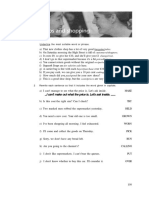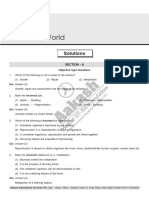@examhelpuz @examhelpuz
Mock 4 READING TEST
Part 1
Read the text. Fill in each gap with ONE word. You must use a word which is somewhere
in the rest of the text.
Glass, in one form or another, has long been in noble service to humans. As one of the most
widely used of manufactured materials, and certainly the most versatile, it can be as
imposing as a telescope mirror the width of a tennis court or as small and simple as a
marble rolling across dirt. The uses of this adaptable 1_______________ have been
broadened dramatically by new technologies glass fibre optics — more than eight million
miles — carrying telephone and television signals across nations, glass ceramics serving as
the nose cones of missiles and as crowns for teeth; tiny glass beads taking radiation doses
inside the body to specific organs, even a new type of glass fashioned of nuclear waste in
order to dispose of that unwanted material.
On the horizon are optical computers. These could store programs and process information
by means of light - pulses from tiny lasers - rather than electrons. And the pulses would
travel over glass 2_______________s, not copper wire. These machines could function
hundreds of times faster than today’s electronic computers and hold vastly more
3_______________. Today fibre optics are used to obtain a clearer image of smaller and
smaller objects than ever before - even bacterial viruses. A new generation of optical
instruments is emerging that can provide detailed imaging of the inner workings of cells. It
is the surge in fibre optic use and in liquid crystal displays that has set the U.S. glass
industry (a 16 billion dollar business employing some 150,000 workers) to building new
plants to meet demand.
But it is not only in technology and commerce that glass has widened its
4_______________s. The use of glass as art, a tradition spins back at least to Roman times,
is also booming. Nearly everywhere, it seems, men and women are blowing
5_______________ and creating works of art. «I didn’t sell a piece of glass until 1975,» Dale
Chihuly said, smiling, for in the 18 years since the end of the dry spell, he has become one
of the most financially successful artists of the 20th century. He now has a new commission
- a glass sculpture for the headquarters building of a pizza company - for which his fee is
half a million dollars.
Today, scientists continue to experiment with new glass mixtures and building designers
test their imaginations with applications of special types of glass. Think of how the tall
buildings in New York could perform a symphony of colours as the glass in them is made to
43
�@examhelpuz @examhelpuz
change 6_______________ instantly.” Glass as instant curtains is available now, but the
cost is exorbitant. As for the glass changing colours instantly, that may come true. Mike
Davies’s vision may indeed be on the way to fulfilment.
Part 2
The people below all want to find some caves that they could visit. There are descriptions
of caves to visit. Decide which cave would be the most suitable for the following people.
7. Marek and his family often visit caves, so would prefer not to have a guide. They’d like
to find caves with interesting rock shapes, and where they could have a swim
8. Jane and her family want a tour of caves that look just as they did when they were
discovered, with original cave paintings. They like caves with water flowing them
9. Mario and his family will be visiting caves during the winter, and don't want anywhere
cold inside or very small. They'd like to have someone show them the caves and explain
their history.
10.Twins Henry and Karina are keen on photography and want to take good pictures inside
and outside the caves they visit. Their parents would like to attend a music performance
inside the caves
11.Justine and her family are experienced at visiting caves, and want to find some that go a
long way underground. They'd also like to see an exhibition about how the caves were
discovered.
12.Fernando and Manuela would like to be in a central location where they can enjoy views
of the city centre. They are hoping to see several musicals. Manuela doesn’t like cats.
13.Ben and Lynne want a house where they can drive to places outside London and learn
about how people used to live. Their two sons want to be able to play tennis and go
swimming. They don’t mind pets.
14.Claire and Tom have two young children. They are an active family who want to see both
the countryside and central London. They don’t have a car so will need to use other
transport.
44
�@examhelpuz @examhelpuz
Caves to visit
A. Hatton Hole The area here isn't attractive, but the temperature inside is comfortable -
there's even a stream for swimming! These caves have been made larger for the music
shows held here. Cave paintings can be seen further underground, and there are books
available.
B. Mara Hollow You’ll need to know all about going into caves to visit this place, as there’s
no guide You can walk comfortably for hundreds of metres, but some sections are quite
narrow. There’s a great display of the caves’ history, with paintings and photos showing
the first people to enter the caves during the 20th century.
C. Maribu caves These caves are perfect for experienced people wishing to visit caves by
themselves, as they're quite safe. And there's plenty to see as the colourful rocks inside
look like strange objects - animals, birds or even vegetables! There's also a big natural
pool you can dive into, so take your costumes
D. Trussack Cavern These huge old caves go underground for miles, and when the
temperature drops outside, it's actually warmer inside! The guides know everything
about the caves, from how they were used thousands of years ago. to their recent
discovery The natural swimming pool and scenery outside are beautiful - perfect for
photos.
E. Kemble Caves You'll need a guide round these caves They’re not deep, but they're
narrow, with streams running through them. However, the rock shapes you’ll see
hanging from the roof are amazing! The views outside are beautiful, and there's a great
exhibition about people living in the caves centuries ago
F. Dragon's Nook These caves are surrounded by beautiful trees and waterfalls. They were
made larger recently to let visitors enter easily, and they’re now big enough to hold
exhibitions and concerts - from pop to classical' Visitors can walk around without a
guide. Take your camera for the original wall paintings.
G. Sorian Hill This is a great place for a swim' Waterfalls flow into rocky pools outside the
entrance, inside, rock has been removed to make a wonderful space for visitors,
although photography isn't allowed In here Classical music plays as you walk around by
yourselves.
H. Canran’s Den These large, deep caves with waterfalls are perfect for photos of the
strange rock shapes. There are pictures on the rock walls done by people living here
centuries ago. Who’s find the caves nowadays haven’t changed at all – including the low
temperatures. Visitors are accompanied by guides.
I. We have a Lovely four-bedroom house away from the city centre. There's a garage, a
garden and antique furniture. The location offers easy access to several beautiful
45
�@examhelpuz @examhelpuz
historical houses by road with a leisure centre and pool just ten minutes away on foot.
We have a dog that needs looking after.
J. I live on the top floor of an old town house in a busy street in central London. It's a small
but very modern flat with blinds and wooden floors. There are lots of small art galleries
nearby and a bus to Camden market. Just around the corner is a gym.
K. We live in a large two-bedroom flat on the third floor of a block in the centre. There's a
balcony, from which you can see many famous buildings and luxury curtains and carpets
in all rooms. Several popular London theatres are just a short walk away. We’d rather
not have visitors with pets.
L. We live in a cottage opposite a large forest with a beautiful lake where you can try
different water sports. You can borrow our bikes to get around the area or take one of
the regular trains to the city centre. There are two first floor bedrooms and an attic
which can be used as a small bedroom.
M. I have a one-bedroom flat with central Mating and great views of south London in a
quiet, safe street. You can try the European restaurants nearby or take a train to central
London It's close to Wimbledon tennis club and an hour from the coast. A spare duvet,
blanket and a fan are available.
46
�@examhelpuz @examhelpuz
Part 3
Read the text and choose the correct heading for each paragraph from the list of headings
below.
There are more headings than paragraphs, so you will not use all of them. You cannot use
any heading more than once.
List of headings
A. Questions arise to be answered.
B. Contrast data between present and past.
C. Initial response of association on the village.
D. Origin of a certain ancient building.
E. Inner structure of the building.
F. Layout of the village to persist in micro-environment.
G. Terms of the village explained.
H. Definition of village type.
I. Difference between village and town.
15.Paragraph 1___
16.Paragraph 2___
17.Paragraph 3___
18.Paragraph 4___
19.Paragraph 5___
20.Paragraph 6___
EXPLORING BRITISH VILLAGE 2
1. The Neolithic longhouse was a long, narrow timber dwelling built by the first farmers
in Europe beginning at least as early as the period 5000 to 6000 BC. The origin of the
name blackhouse is of some debate. It could be less than 150 years old and may have
been synonymous with inferior. On Lewis, in particular, it seems to have been used to
distinguish the older blackhouses from some of the newer white-houses (Scottish Gaelic:
taigh-geal, Irish: tí geal, tí bán), with their mortared stone walls. There may also be some
confusion arising from the phonetic similarity between the ‘dubh’ , meaning black and
56
47
�@examhelpuz @examhelpuz
taghadh meaning thatch. The houses in Scotland were built high rather than wide;
however, some were built small and wide.
2. The buildings were generally built with double-wall dry-stone walls packed with earth
and wooden rafters covered with a thatch of turf with cereal straw or reed. The floor
was generally flagstones or packed earth and there was a central hearth for the fire.
There was no chimney for the smoke to escape through. Instead, the smoke made its
way through the roof. The blackhouse was used to accommodate livestock as well as
people. People lived at one end and the animals lived at the other with a partition
between them.
3. It is estimated that there are over ten thousand villages in Britain, yet defining the term
‘village’ isn’t as simple as it may at first sound. When does a hamlet become a village?
And when does a village become a town?
4. Strictly speaking the term ‘village’ comes from the Latin ‘villaticus’, which roughly
translates as ‘a group of houses outside a villa farmstead’. Today a village is understood
as a collection of buildings (usually at least 20) that is larger than a hamlet, yet smaller
than a town, and which contains at least one communal or public building. This is most
commonly the parish church, though it can be a chapel, school, public house, shop, post
office, smithy or mill. Villagers will share communal resources such as access roads, a
water supply, and usually a place of worship
5. A hamlet is a smaller grouping of buildings that don’t necessarily have any public or
service buildings to support it. A significant difference is that it won’t have a parish
church like a village does, and most hamlets contain only between three and twenty
buildings.
6. The point at which a village becomes a town is difficult to determine and is probably
best defined by those who live there. However, since the Middle Ages, the term ‘town’
has been a legal term that refers to the fact that the community has a borough charter.
The situation is confused by the fact that there are many town-like suburban
communities calling themselves villages (for example, Oxton Village in Birkenhead), as
well as designed suburban ‘villages’ such as those built under the Garden Village
Movement.
48
�@examhelpuz @examhelpuz
Part 4
Read the following text for questions 21-29
AUSTRALIA'S MEGAFAUNA CONTROVERSY
Just how long did humans live side by side with megafauna in Australia? Barry Brook,
Richard Gillespie and Paul Martin dispute previous claims of a lengthy coexistence
Over the past 50 millennia, Australia has witnessed the extinction of many species of large
animals, including a rhinoceros-sized wombat and goannas the size of crocodiles Debate
about the possible cause of these extinctions has continued for more than 150 years and
one the crucial questions raised is how long humans and megafauna coexisted in Australia.
We need to know the overlap of time to make an informed choice between the two main
theories regarding the causes of these extinctions. If humans and megafauna coexisted for
a protracted period then climate change is the more likely cause. However, if the
megafauna became extinct shortly after the arrival of humans, then humans are the likely
culprits
The archaeological site at Cuddie Springs in eastern Australia appears to be well preserved.
This dusty claypan holds within its sediments a rich cache of flaked stone and seed-grinding
tools, and side by side with these clear signals of human culture are the bones of a dozen or
more species of megafauna. Drs Judith Field and Stephen Wroe of the University of Sydney,
who excavated the site, claim that it provides unequivocal evidence of a long overlap of
humans and megafauna, and conclude that aridity leading up to the last Ice Age brought
about their eventual demise. In the long-standing explanation of this site, artefacts such as
stone tools and extinct animals remain were deposited over many thousands of years in an
ephemeral lake- a body of water existing for a relatively short time - and remained in place
and undisturbed until the present day.
There is no disputing the close association of bones and stones at Cuddie Springs, as both
are found 1 to 1.7 metres below the modern surface. The dating of these layers is accurate:
ages for the sediments were obtained through radiocarbon dating of charcoal fragments
and luminescence dating of sand grains from the same levels (revealing when a sample was
last exposed to sunlight). Intriguingly, some of the stone show surface features indicating
their use for processing plants, and a few even have well-preserved blood and hair residues
suggesting they were used in butchering animals.
But is the case proposed by Field aside Wroe clear-cut? We carried out a reanalyse of the
scientific data from Cuddie Springs that brings into question their conclusions. The amount
49
�@examhelpuz @examhelpuz
of anthropological evidence found at the site is remarkable: we estimate there are more
than 3 tonnes of charcoal and more than 300 tonnes of stone buried there. Field and Wroe
estimate that there are approximately 20 million artefacts. This plethora of tools is hard to
reconcile with a site that was only available for occupation when the lake was dry.
Furthermore, no cultural features such as oven pits have been discovered. If the sediment
layers have remained undisturbed since being laid down, as Field and Wroe contend, then
the ages of those sediments should increase with depth. However, our analysis revealed a
number of inconsistencies.
First, the charcoal samples are all roughly 36,000 years old. Second, sand in the two upper
levels is considerably younger than charcoal from the same levels. Third, Field and Wroe say
that the tools and seed-grinding stones used for plant and animal processing are accient,
yet they are very similar to implements found elsewhere that were in use only a few
thousand years ago. Also interest is the fact that a deep drill core made a mere 60 metres
from the site recovered no stone artefact or fossil bones whatsoever. These points suggests
strongly that the sediments have been moved about and some of the old charcoal has been
re-deposited in younger layers. Indeed, one sample of cow bone found I metre below the
surface came from sediments where charcoal dated at 6,000 and 23,000 years old is mixed
with 17,000-year-old sand. The megafauna bones themselves have not yet dated, although
new technological developments make this a possibility in the near future.
We propose that the archaeologists have actually been sampling the debris carried by
ancient flood channels beneath the site, including charcoal transported from bushfires that
intermittently occurred within the catchment. Flood events more likely explain the
accumulation of megafauna remains, and could have mixed old bones With fresh deposits.
European graziers also disturbed the site in 1876 by constructing a well to provide water
their cattle. Given the expense of well-digging, we speculate that the graziers made sure it
was protected from the damage caused by cattle hooves by lining the surface with small
stones collected from further afield, including prehistoric quarries. This Idea Is consistent
with the thin layer of stones spread over a large area, with cattle occasionally breaking
through the gravel surface and forcing the stone and even cattle bones deeper into the
waterlogged soil.
The lack of conclusive evidence that humans and megafauna coexisted for a lengthy period
casts doubt on Field and Wroe's assertion that climate change was responsible for the
extinction of Australia's megafauna. However, we do not suggest that newly arrived, well-
armed hunters systematically slaughtered all the large beasts they encountered. Recent
studies based on the biology of modern-day large
50
�@examhelpuz @examhelpuz
Mammals, combined with observations of people who still practise a traditional hunter-
gatherer lifestyle, reveal an unexpected paradox and suggest a further possible explanation
as to what happened. Using a mathematical model, It was found that a group of 10 people
killing only one juvenile Diprotodon each year would be sufficient to bring about the
extinction of that spaces within 1,000 years. This suggests that here, as in other parts of the
word, the arrival of humans in lands previously inhabited only by animals created a volatile
combination in which large animals fared badly.
Note: The Diprotodon (a rhinoceros-sized wombat), an example of Australia’s now extinct
megafauna
Questions 21-24
Do the following statements agree with the claims of the writer in Reading Passage
21.Field and Wroe argue that findings at the Cuddie Springs site show that people lived in
this area at the same time as megafauna.
A) True B) False C) Not Given
22.Field and Wroe believe it is likely that smaller megafauna species survived the last Ice
Age
A) True B) False C) Not Given
23.The writers believe that the dating of earth up to 1.7m below the present surface at
Cuddie Springs is unreliable.
A) True B) False C) Not Given
24.Some artefacts found at Cuddie Springs were preserved well enough to reveal their
function
A) True B) False C) Not Given
Questions 25-29
Choose the correct letter, A, B, C or D
25.What conclusions did the writers reach about the inconsistencies in the data from
Cuddie Springs?
A. The different layers of sediment have been mixed over time.
B. The sand evidence is unhelpful and should be disregarded.
C. The area needs to be re-examined when technology improves.
D. The charcoal found in the area cannot be dated.
26.According to the writers, what impact could a natural phenomenon have had on this
site?
51
�@examhelpuz @examhelpuz
A. Floods could have caused the death of the megafauna.
B. Floods could have disturbed the archaeological evidence.
C. Bushfires could have prevented humans from settling in the area for any length of
time
D. Bushfires could have destroyed much of the evidence left by megafauna and humans.
27. What did the writers speculate about the people who lived at this site in 1876?
A. They bred cattle whose bones could have been confused with megafauna
B. They found that the soil was too waterlogged for farming
C. They allowed cattle to move around freely at the site
D. They brought stones there from another area
28. In the final paragraph what suggestion do the writers hide about Australia’s
megafauna?
A. A rapid change in climate may have been responsible for the extinction of the
megafauna.
B. Megafauna could have died out as a result of small numbers being killed year after
year.
C. The population of humans at that time was probably insufficient to cause the
extinction of the megafauna.
D. The extinction of ancient animals should not be compared to that of modern-day
species.
29. Which of the following best represents the writers' criticism of Field and Wroe?
A. Their methods were not well thought out
B. Their excavations did not go deep enough.
C. Their technology failed to obtain precise data.
D. Their conclusions were based on inconsistent data.
Part 5
CAN SCIENTISTS TELL US: WHAT HAPPINESS IS?
Economists accept that if people describe themselves as happy, then they are happy.
However, psychologists differentiate between levels of happiness. The most immediate
type involves a feeling; pleasure or joy. But sometimes happiness is a judgment that life is
satisfying, and does not imply an emotional state. Esteemed psychologist Martin Seligman
has spearheaded an effort to study the science of happiness. The bad news is that we’re
not wired to be happy. The good news is that we can do something about it. Since its
origins in a Leipzig laboratory 130 years ago, psychology has had little to say about
goodness and contentment. Mostly psychologists have concerned themselves with
52
�@examhelpuz @examhelpuz
weakness and misery. There are libraries full of theories about why we get sad, worried,
and angry. It hasn’t been respectable science to study what happens when lives go well.
Positive experiences, such as joy, kindness, altruism and heroism, have mainly been
ignored. For every 100 psychology papers dealing with anxiety or depression, only one
concerns a positive trait.
A few pioneers in experimental psychology bucked the trend. Professor Alice Isen of Cornell
University and colleagues have demonstrated how positive emotions make people think
faster and more creatively. Showing how easy it is to give people an intellectual boost, Isen
divided doctors making a tricky diagnosis into three groups: one received candy, one read
humanistic statements about medicine, one was a control group. The doctors who had
candy displayed the most creative thinking and worked more efficiently. Inspired by Isen
and others, Seligman got stuck in. He raised millions of dollars of research money and
funded 50 research groups involving 150 scientists across the world. Four positive
psychology centres opened, decorated in cheerful colours and furnished with sofas and
baby-sitters. There were get-togethers on Mexican beaches where psychologists would
snorkel and eat fajitas, then form “pods” to discuss subjects such as wonder and awe. A
thousand therapists were coached in the new science.
But critics are demanding answers to big questions. What is the point of defining levels of
haziness and classifying the virtues? Aren’t these concepts vague and impossible to pin
down? Can you justify spending funds to research positive states when there are problems
such as famine, flood and epidemic depression to be solved? Seligman knows his work can
be belittled alongside trite notions such as “the power of positive thinking”. His plan to stop
the new science floating “on the waves of self- improvement fashion” is to make sure it is
anchored to positive philosophy above, and to positive biology below.
And this takes us back to our evolutionary past Homo sapiens evolved during the
Pleistocene era (1.8 m to 10,000 years ago), a time of hardship and turmoil. It was the Ice
Age, and our ancestors endured long freezes as glaciers formed, then ferocious floods as
the ice masses melted. We shared the planet with terrifying creatures such as mammoths,
elephant-sized ground sloths and sabre-toothed cats. But by the end of the Pleistocene, all
these animals were extinct. Humans, on the other hand, had evolved large brains and used
their intelligence to make fire and sophisticated tools, to develop talk and social rituals.
Survival in a time of adversity forged our brains into a persistent mould. Professor Seligman
says: “Because our brain evolved during a time of ice, flood and famine, we have a
catastrophic brain. The way the brain works is looking for what’s wrong. The problem is,
62
53
�@examhelpuz @examhelpuz
that worked in the Pleistocene era. It favoured you, but it doesn’t work in the modem
world”.
Although most people rate themselves as happy, there is a wealth of evidence to show that
negative thinking is deeply ingrained in the human psyche. Experiments show that we
remember failures more vividly than success. We dwell on what went badly, not what went
well. Of the six universal emotions, four anger, fear, disgust and sadness are negative and
only one, joy, is positive. (The sixth, surprise, is neutral). According to the psychologist
Daniel Nettle, author of Happiness, and one of the Royal Institution lectures, the negative
emotion each tells us “something bad has happened” and suggest a different course of
action.
What is it about the structure of the brain that underlies our bias towards negative
thinking? And is there a biology of joy? At Iowa University, neuroscientist studied what
happens when people are shown pleasant and unpleasant pictures. When subjects see
landscapes or dolphins playing, part of the frontal lobe of the brain becomes active. But
when they are shown unpleasant images a bird covered in oil, or a dead soldier with part of
his face missing the response comes from more primitive parts of the brain. The ability to
feel negative emotions derives from an ancient danger-recognition system formed early in
the brain’s evolution. The pre-frontal cortex, which registers happiness, is the part used for
higher thinking, an area that evolved later in human history.
Our difficulty, according to Daniel Nettle, is that the brain systems for liking and wanting
are separate. Wanting involves two ancient regions the amygdala and the nucleus
accumbens that communicate using the chemical dopamine to form the brain’s reward
system. They are involved in anticipating the pleasure of eating and in addiction to drugs. A
rat will press a bar repeatedly, ignoring sexually available partners, to receive electrical
stimulation of the “wanting” parts of the brain. But having received brain stimulation, the
rat eats more but shows no sign of enjoying the food it craved. In humans, a drug like
nicotine produces much craving but little pleasure.
In essence, what the biology lesson tells us is that negative emotions are fundamental to
the human condition and it’s no wonder they are difficult to eradicate. At the same time, by
a trick of nature, our brains are designed to crave but never really achieve lasting
happiness.
54
�@examhelpuz @examhelpuz
Questions 30-35
Complete the following summary of the paragraphs of Reading Passage
Using NO MORE THAN FOUR WORDS from the Reading Passage for each answer.
A few pioneers in experimental psychology study what happens when lives go well.
Professor Alice divided doctors, making a tricky experiment, into three groups: besides the
one control group, the other two either are asked to read humanistic statements about
drugs or received 30________________ The latter displayed the most creative thinking and
worked more efficiently. Since critics are questioning the significance of
the 31________________ for both levels of happiness and classification for the virtues.
Professor Seligman countered in an evolutional theory: survival in a time of adversity forged
our brains into the way of thinking for what’s wrong because we have
a 32________________.
There is bountiful of evidence to show that negative thinking is deeply built in the human
psyche. Later, at Iowa University, neuroscientists studied the active parts in brains to
contrast when people are shown pleasant and unpleasant pictures. When positive images
like 33________________ are shown, part of the frontal lobe of the brain becomes active.
But when they are shown unpleasant image, the response comes
from 34________________ of the brain.
Question 35
Choose the correct letter A, B, C or D.
According to Daniel Nettle in the last two paragraphs, what is true as the scientists can tell
us about happiness:
A. Brain systems always mix liking and wanting together.
B. Negative emotions can be easily rid of if we think positively.
C. Happiness is like nicotine we are craving for but get little pleasure.
D. The inner mechanism of human brains does not assist us to achieve durable happiness
55

























































































